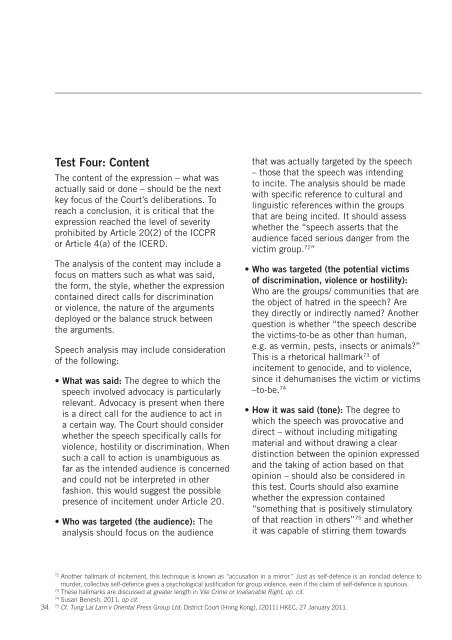ARTICLE-19-policy-on-prohibition-to-incitement
ARTICLE-19-policy-on-prohibition-to-incitement
ARTICLE-19-policy-on-prohibition-to-incitement
Create successful ePaper yourself
Turn your PDF publications into a flip-book with our unique Google optimized e-Paper software.
Test Four: C<strong>on</strong>tent<br />
The c<strong>on</strong>tent of the expressi<strong>on</strong> – what was<br />
actually said or d<strong>on</strong>e – should be the next<br />
key focus of the Court’s deliberati<strong>on</strong>s. To<br />
reach a c<strong>on</strong>clusi<strong>on</strong>, it is critical that the<br />
expressi<strong>on</strong> reached the level of severity<br />
prohibited by Article 20(2) of the ICCPR<br />
or Article 4(a) of the ICERD.<br />
The analysis of the c<strong>on</strong>tent may include a<br />
focus <strong>on</strong> matters such as what was said,<br />
the form, the style, whether the expressi<strong>on</strong><br />
c<strong>on</strong>tained direct calls for discriminati<strong>on</strong><br />
or violence, the nature of the arguments<br />
deployed or the balance struck between<br />
the arguments.<br />
Speech analysis may include c<strong>on</strong>siderati<strong>on</strong><br />
of the following:<br />
• What was said: The degree <strong>to</strong> which the<br />
speech involved advocacy is particularly<br />
relevant. Advocacy is present when there<br />
is a direct call for the audience <strong>to</strong> act in<br />
a certain way. The Court should c<strong>on</strong>sider<br />
whether the speech specifically calls for<br />
violence, hostility or discriminati<strong>on</strong>. When<br />
such a call <strong>to</strong> acti<strong>on</strong> is unambiguous as<br />
far as the intended audience is c<strong>on</strong>cerned<br />
and could not be interpreted in other<br />
fashi<strong>on</strong>. this would suggest the possible<br />
presence of <strong>incitement</strong> under Article 20.<br />
• Who was targeted (the audience): The<br />
analysis should focus <strong>on</strong> the audience<br />
that was actually targeted by the speech<br />
– those that the speech was intending<br />
<strong>to</strong> incite. The analysis should be made<br />
with specific reference <strong>to</strong> cultural and<br />
linguistic references within the groups<br />
that are being incited. It should assess<br />
whether the “speech asserts that the<br />
audience faced serious danger from the<br />
victim group. 72 ”<br />
• Who was targeted (the potential victims<br />
of discriminati<strong>on</strong>, violence or hostility):<br />
Who are the groups/ communities that are<br />
the object of hatred in the speech Are<br />
they directly or indirectly named Another<br />
questi<strong>on</strong> is whether “the speech describe<br />
the victims-<strong>to</strong>-be as other than human,<br />
e.g. as vermin, pests, insects or animals”<br />
This is a rhe<strong>to</strong>rical hallmark 73 of<br />
<strong>incitement</strong> <strong>to</strong> genocide, and <strong>to</strong> violence,<br />
since it dehumanises the victim or victims<br />
–<strong>to</strong>-be. 74<br />
• How it was said (t<strong>on</strong>e): The degree <strong>to</strong><br />
which the speech was provocative and<br />
direct – without including mitigating<br />
material and without drawing a clear<br />
distincti<strong>on</strong> between the opini<strong>on</strong> expressed<br />
and the taking of acti<strong>on</strong> based <strong>on</strong> that<br />
opini<strong>on</strong> – should also be c<strong>on</strong>sidered in<br />
this test. Courts should also examine<br />
whether the expressi<strong>on</strong> c<strong>on</strong>tained<br />
“something that is positively stimula<strong>to</strong>ry<br />
of that reacti<strong>on</strong> in others” 75 and whether<br />
it was capable of stirring them <strong>to</strong>wards<br />
72<br />
Another hallmark of <strong>incitement</strong>, this technique is known as “accusati<strong>on</strong> in a mirror.” Just as self-defence is an ir<strong>on</strong>clad defence <strong>to</strong><br />
murder, collective self-defence gives a psychological justificati<strong>on</strong> for group violence, even if the claim of self-defence is spurious.<br />
73<br />
These hallmarks are discussed at greater length in Vile Crime or Inalianable Right, op. cit.<br />
74<br />
Susan Benesh, 2011, op cit.<br />
75<br />
34 Cf. Tung Lai Lam v Oriental Press Group Ltd, District Court (H<strong>on</strong>g K<strong>on</strong>g), [2011] HKEC, 27 January 2011.


